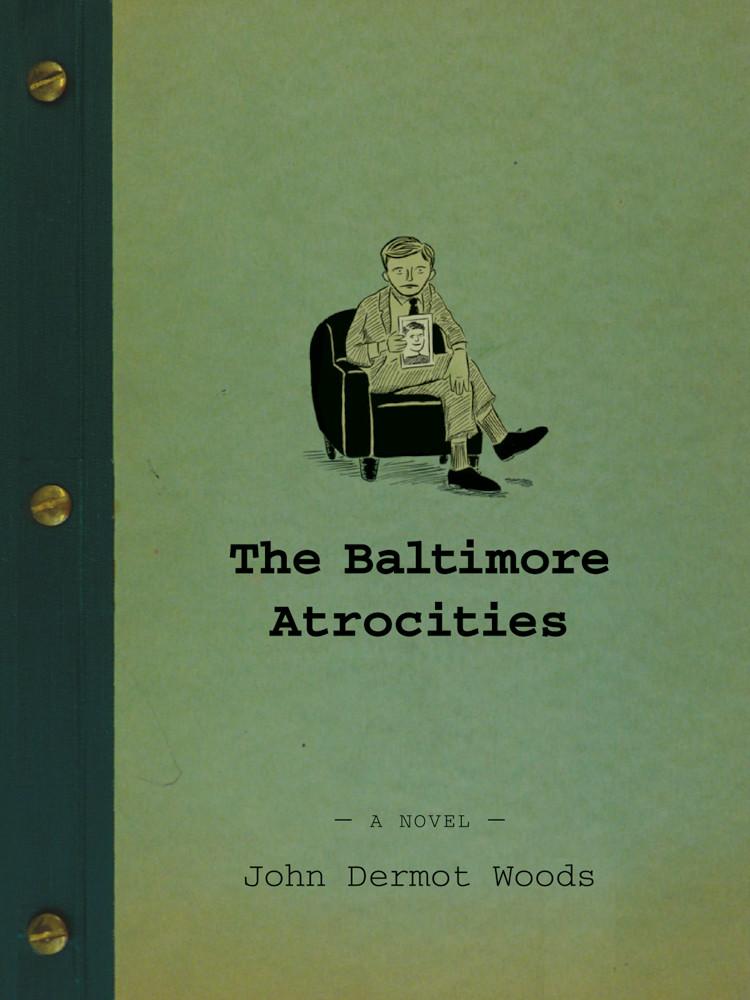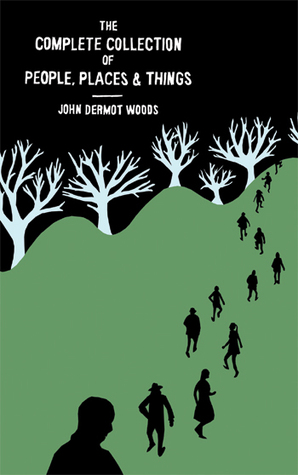ohn Dermot Woods is a writer and cartoonist based in Brooklyn, New York. I first met him when Radix Media printed some of his mini-comics five or six years ago, and we’ve managed to keep in touch over the years. Evolving from just comics, he’s gone on to do illustrated novels like The Baltimore Atrocities (Coffee House Press) and The Complete Collection of People, Places & Things (BlazeVOX Books). I caught up with him to talk about his more recent projects, and about what it means to pursue rather than discover.
Can you briefly introduce yourself and talk about how you came to this work?
I’ve been making stories for about twenty years now. I’ve always had a passion for words and pictures. Like all of us, I hope. At times I’ve focused on painting, dramatic writing, drawing, and writing fictional stories. I use whatever I have to make things. I’m comfortable “orchestrating” things, especially on a small scale. I think the comics page suits me, in that it’s kind of a contained production in which I can choose and arrange all of the elements. The same goes for fiction. Conceptually, all my work is a sort of diorama.

You started off in comics but then veered into doing illustrated novels like The Baltimore Atrocities, which is a fantastic book. How do you decide to do a comic versus an illustrated novel? What about the story tells you that it has to be one or the other?
I’ve always written and drawn pictures, but for a long time they were discrete practices. I started as a painter. That’s what I studied in undergrad. But the narrative drive was always there. Over time I began to illustrate my own prose stories and eventually that interplay became more organic and my work evolved into comics. But it varies with each project. Recently my work has become more text driven. Still the images remain, as in some of my more recent work. The story usually comes to me in a certain form. I discover it within the form. I’m not the kind of writer who sees a story whole and then sets out to “capture” it. The comic is found on the drawing board, the story within the sentences, etc.
I saw an interview you did with Fiction Writers Review and the title of it was “Pursuit, Not Discovery.” I think that’s a good tagline for The Baltimore Atrocities, but do you think that theme comes up in your other work as well?
Definitely. That’s why interviews like this are difficult for me. I haven’t come to many conclusions about my own work. Like many artists, I fear “discovering” something about it. That will fix it in place. I’m very bad at explaining a given work, even why I wanted to make it. And that may frustrate people, but a story or picture needs to vibrate. It can’t be allowed to settle. That’s when it dies. The edges need to be left rough if a work is going to remain vital after it’s published.
“I’m not the kind of writer who sees a story whole and then sets out to ‘capture’ it. The comic is found on the drawing board, the story within the sentences.”
 I remember the first mini-comics we printed for you in 2013 or so, and since then we’ve done a few other projects together. Do you find that it’s easier to visualize these stories in print versus looking at a computer screen? Does it become real to you when it’s printed?
I remember the first mini-comics we printed for you in 2013 or so, and since then we’ve done a few other projects together. Do you find that it’s easier to visualize these stories in print versus looking at a computer screen? Does it become real to you when it’s printed?
Definitely. I am a total materialist (as much as it pains me to write that). I love the physical object. I love to hold things and I put a lot of stock in judging books by their covers. For instance, I get really excited about letterpress covers. Because I love the feel of letterpress, the impression bit into the paper. Even when I draw an image to be printed letterpress, I think about that ridge along the edge of the line created when the ink presses into the paper. I’m trying to be less precious about stuff, throw more stuff out—as is today’s fashion—but I’m clearly not doing a very good job.
Who are some of your favorite authors or artists right now? What keeps you inspired?
This is usually the easiest question to answer, because I’m such an enthusiast. (I just took a Meyers-Briggs test for the first time and it turns out that that’s my exact personality type: enthusiast.) But the easy answers aren’t coming to me right now. It could be because I’m surrounded by so much good art that it’s paralyzing, which is true. But it’s probably the result of the more hermetic existence that I’ve been living. I’ve been trying to live more slowly, read more slowly, watch more slowly. Part of that is relying on the Internet far less. The model of online consumption is engineered to be cursory and swift. But, now I’m realizing, I am missing out. Being away from Instagram and the New York Times is a highly recommended experience, but some babies do get thrown out with the bathwater. Like a constant stream of new and beautiful work. So, right now, I’d have to say, stillness is what inspires me.
“A story or picture needs to vibrate. It can’t be allowed to settle. That’s when it dies.”
What’s next on the horizon for you? More comics? More novels?
Yes and yes. I work on many things at once. The projects I’m deepest into are a novel about family tragedy amidst a broader climactic tragedy, and a graphic novel I’ve been working on for years. I’m also writing a movie about a famous television painter. He lived a fascinating life.
You’ve pretty much unplugged from social media these days, which is admirable, but bad news for people who want to stay updated! What’s the best way to stay on top of your projects?
Still trying to figure that out. I’ve been getting more done than ever because unplugging allows me long periods of concentrated focus. I’ve been meaning to post some stuff to my website, so I plan to do that. Eventually. And I think I’ll send out an email every six months or so to update people. People complain about junk email, but I love getting art updates from my friends. (If you’ve got a TinyLetter or something like that and you make good art—put me on your list.) It’s way better than Instagram, trust me.
Community Spotlight is a blog series that seeks to connect people and build power. Each post will feature a person or organization doing great work in their community and fighting for a more just world. We interview writers, illustrators, podcasters, filmmakers, activists, and more. Subscribe today and let’s start building together.





